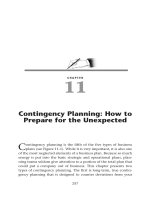The 1-Page Contingency Plan
Bạn đang xem bản rút gọn của tài liệu. Xem và tải ngay bản đầy đủ của tài liệu tại đây (962.32 KB, 27 trang )
The 1-Page Contingency Plan
Y
ou can easily build a complete 1-Page Contingency Plan as a
result of this activity. Modify this form as necessary. Use the
front and back if you need more space, but keep it to one page.
377
APPENDIX
F
This Page Intentionally Left Blank
Appendix F The 1-Page Contingency Plan
379
This Page Intentionally Left Blank
Preconference Assignment
P
lease answer the following questions to the best of your ability.
Bring your work to the planning conference. Be prepared to dis-
cuss your responses in detail.
G
UIDANCE
This is a description of restrictions placed on you. Your plan must
not exceed these boundaries.
381
APPENDIX
G
Appendix G Preconference Assignment
382
1. What is your guidance?
2. Are you now operating outside of your guidance?
3. What do you think your guidance might look like?
V
ISION
Describe what the company could look like at some long-term date.
1. What do you want to be in five to ten years, as a
company?
2. What would that business look like? Please describe.
3. What should your vision statement be? Attempt a draft.
F
OCUS
This is a description of your single driving force.
1. What is your single focus? Pick from one of the
following:
■ Customer intimate—The customer is in the center of
your business for problem solving.
■ Plans driven—There is a need for high compliance for
success.
■ Operationally excellent—There is no wasted motion in
the system.
■ Products driven—There is a steady flow of new or
continuously improved products.
■ Properties driven—There is maximum focus in keeping
the physical or intellectual properties in use every day.
■ Payoff driven—There is a clear understanding of why
customers buy or use your products, which is usually
perceived status.
Appendix G Preconference Assignment
383
2. What problems will occur when you move to a single
focus?
A
SSUMPTIONS
You make your plan using baselines. If they change, your plan must
change.
1. What assumptions can you make for your industry?
2. What assumptions can you make for your company?
M
ISSION
Your mission is a definition of what business you are in today. What
is your single-sentence mission statement? Attempt a draft now. Be
prepared to conduct a detailed mission analysis at the planning
conference.
Related to the mission are a specified task and implied tasks.
■ Specified Task. This identifies the single thing you must do
to make money and stay viable. To identify a specified
task, ask:
1. What business are you in?
2. Does everyone agree to this single element?
■ Implied Tasks. These identify all the things that must be
accomplished for your mission to succeed.
1. What are your implied tasks?
2. How well are these tasks understood?
P
HILOSOPHY
The crux here is how you plan to run your business.
1. Write your philosophy statement.
2. Is there a gap between what you say and what you do?
3. How do you propose to close the gap?
V
ALUES
Your values are those things you hold important to the organiza-
tion as behavioral guidelines.
1. List your core values—that is, those deep-seated
convictions that are important to you.
2. Define in action terms what they mean.
3. Is there a gap between what you say and what you do?
4. How do you propose to close the gap?
P
RINCIPLES
These are the basic truths by which you lead and manage your busi-
ness.
1. List the principles by which you intend to run your
business.
2. Is there a gap between what you say and what you do?
3. How do you propose to close the gap?
S
TRATEGIC
G
OALS
Use bold statements to describe what you expect to accomplish.
Appendix G Preconference Assignment
384
Appendix G Preconference Assignment
385
1. What are the four or five bold goals you need to ac-
complish?
2. What will prevent you from accomplishing these goals?
O
BJECTIVES
Intermediate steps are necessary to accomplish each of the more
broad, strategic goals.
1. What are the four or five objectives for each goal?
2. Please write your specific objectives.
T
ASKS
Create a detailed list of all the items that must be accomplished.
The focus is on the short term for the coming year. Tasks are
assigned to specific persons with time limits set.
1. What are all the tasks that must be completed for the next
year?
2. How many of these tasks will be assigned to you?
S
TRATEGIES
As important as your goals is how you plan to move forward.
Strategies bridge the present to the future attainment of your goals.
1. What are your strategies?
2. Please list and describe each strategy.
T
ACTICS
A tactic is any short-term action to achieve a specific goal (i.e.,
“how” you plan to execute your mission).
1. What are your tactics?
2. Please list and describe various tactics to achieve specific
goals.
S
TRATEGIC
I
NTENT
This is a recapitulation of what you intend to implement in the
future and how you intend to do it.
1. What is your strategic intent?
2. Be prepared to state this intent in public.
P
ROCESSES
Tasks are usually grouped in processes. These processes can be
sources of great inefficiencies.
1. Name your major processes.
2. Which process do you suspect of being inefficient?
3. Who should be involved with each process?
A
NNUAL
T
ARGETS
These are the specific performance measures you will work toward
meeting.
1. What do you wish to achieve next year?
2. Are these targets realistic and attainable?
Appendix G Preconference Assignment
386









